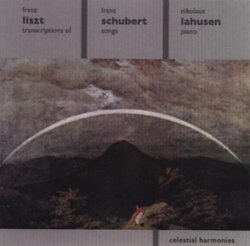| All Artists: Franz Liszt, Nikolaus Lahusen Title: Franz Liszt Transcriptions of Franz Schubert Songs Members Wishing: 1 Total Copies: 0 Label: Celestial Harmonies Release Date: 5/27/2003 Genre: Classical Styles: Chamber Music, Historical Periods, Classical (c.1770-1830) Number of Discs: 1 SwapaCD Credits: 1 UPC: 013711322828 |
Search - Franz Liszt, Nikolaus Lahusen :: Franz Liszt Transcriptions of Franz Schubert Songs
 | Franz Liszt, Nikolaus Lahusen Franz Liszt Transcriptions of Franz Schubert Songs Genre: Classical
This is Nikolaus Lahusen's first recording of Franz Liszt works, although it could be considered his third recording of Franz Schubert's works for Celestial Harmonies. It features Liszt's transcriptions for piano solo o... more » |
Larger Image |
CD Details
Synopsis
Album Description
This is Nikolaus Lahusen's first recording of Franz Liszt works, although it could be considered his third recording of Franz Schubert's works for Celestial Harmonies. It features Liszt's transcriptions for piano solo of Schubert's works, with the vocal parts of the original `lieder' taken over by the piano. The transcriptions presented here adhere closely to Schubert's original compositional structure without any paraphrasing or free fantasies.Franz Liszt explained what moved him to his intense preoccupation with Franz Schubert's lieder between the years of 1833 and 1845 during his 1838 visit in Vienna: "I heard in the salons, with vivid pleasure and sentimentality bringing tears to my eyes, an artistic friend, the Baron von Schoenstein, present Schubert's lieder. The French translation renders only a very incomplete sense of how this mostly-very-lovely poetry connects to the music of Schubert, the most poetic musician ever to live. The German language is so admirable in the area of sentimentality, perhaps only a German is capable of comprehending the naiveté and fantastic aspects of so many of these compositions, their capricious appeal, their melancholy letting-go."Commenting on his new recording, Lahusen writes "After recording works of Franz Schubert on the Graf fortepiano (Hammerfluegel), I am coming back to Schubert, this time with Liszt's assistance and on a modern Fazioli piano. The magnificent Valse Sentimentale A Major provides a little bridge between the two very different CDs since it is recorded on both. For me, the transcriptions are primarily works of Schubert that have been elevated to piano works in their own right thanks to the unique talent of Franz Liszt as both a pianist and composer. The complex various levels of the transcriptions, consisting of two to three autonomous piano accompaniments and one line of melody, is what makes the pieces so appealing to the pianist. Likewise, this is what gives the works their high educational value: Liszt himself taught these works well into his elder years.What fascinates me the most in these transcriptions is the two, at first appearance, conflicting elements developing side-by-side: on one hand, the vast pianistic compositional means Liszt - as no other - possessed which he makes use of in these transcriptions at his best, and yet the simplicity and inwardness of the `simple feelings' of Schubert's original expression."

 Track Listings (15) - Disc #1
Track Listings (15) - Disc #1


